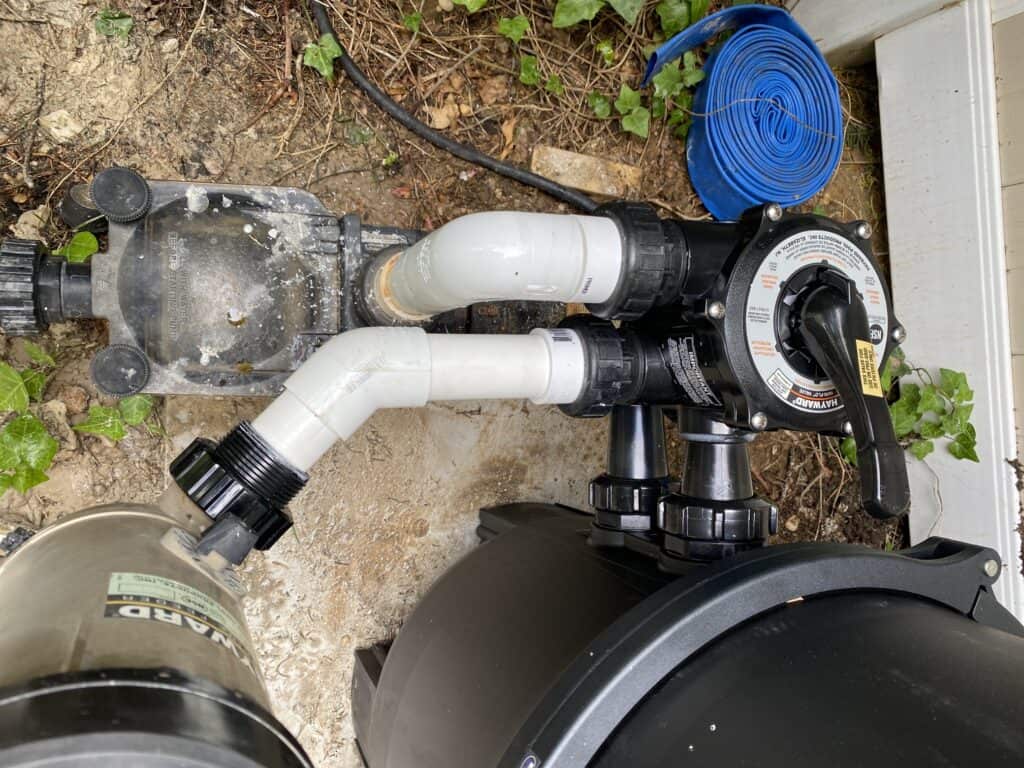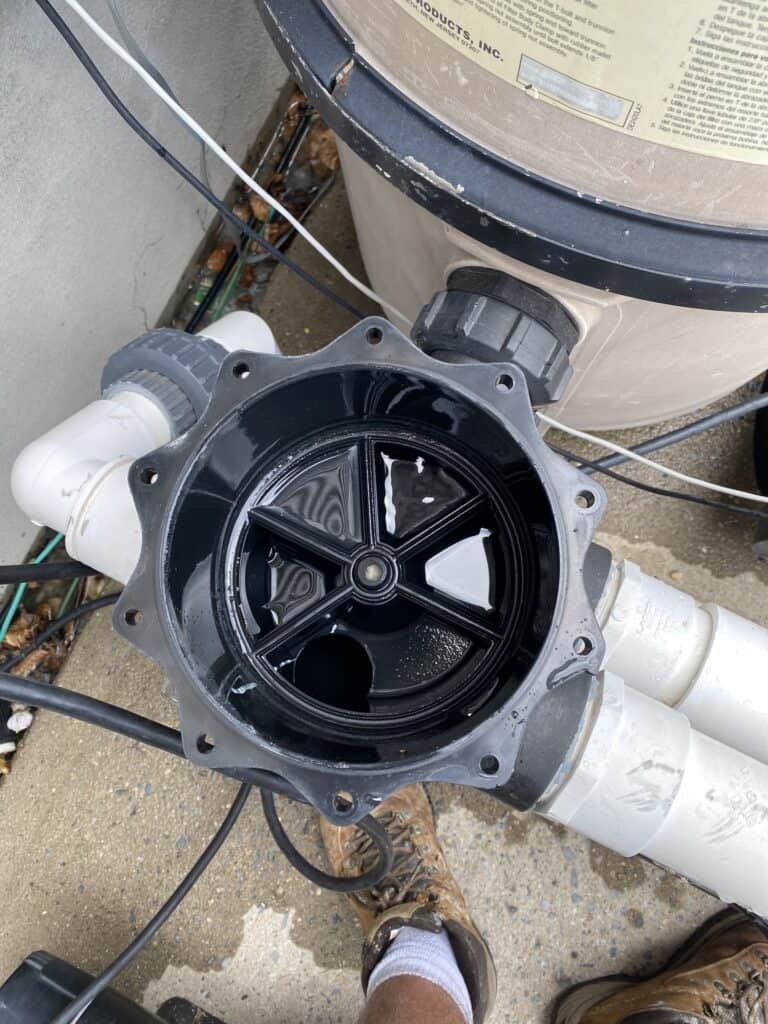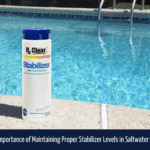We will delve into the nuts and bolts of your swimming pool in this post. We’re shedding light on an essential yet often overlooked component – the multiport valve.
A multiport valve, for those who may not be familiar, is the heart of your pool’s filtration system. It’s a device with multiple ports and a handle to direct water flow, allowing various operations of the pool system, such as filtering, backwashing, rinsing, recirculating, and even draining the pool.
The multiport valve plays a pivotal role in maintaining the clarity and cleanliness of your pool’s water by enabling these different functions.
It is essential to have the multiport valve fully functioning. A faulty or malfunctioning valve can wreak havoc on your pool system and the quality of your swim.
Leaks, loss of water pressure, poor filtration, and even the potential to damage your pool pump are some issues that can arise.
A compromised valve can let debris back into your pool or prevent the backwashing process from working correctly, leading to poor water quality.
Over time, this could translate into more extensive – and expensive problems.
That’s why it’s crucial to be aware of signs that your multiport valve might be reaching the end of its lifespan.
It’s about ensuring your pool system’s longevity and the swimmers’ health.
Understanding the Multiport Valve
Let’s take a moment to understand the workings of a multiport valve.

The multiport valve is aptly named for its multiple ports, each corresponding to a specific operation within your pool’s filtration system.
This valve is the control center that manages the direction of water flow and dictates whether your pool is in the process of filtering, backwashing, rinsing, recirculating, or draining.
By switching the handle to the appropriate setting, you control the flow of water in your system, ensuring efficient operation and clean, clear water.
The lifespan of a multiport valve can depend on several factors, including the frequency of its use, the chemical balance of your pool water, and how well the overall pool system is maintained.
However, you can expect a multiport valve to last between 3 to 5 years under normal operating conditions.
That said, it’s essential to note that ‘lifespan’ does not mean the valve will suddenly fail after this period.
Instead, it’s a period where wear and tear can begin to affect performance, and more careful monitoring is required.
Let’s learn about the signs of a potential multiport valve issue.
Top 7 Signs that Your Multiport Valve Needs Replacement
Knowing what to look for can help you catch potential issues before they become substantial problems.
It is vital to keep a watchful eye on the multiport valve and seek professional assistance if you notice any of these signs:
Leakage
Perhaps the most visible red flag that there’s something amiss with your multiport valve is the presence of water leakage.
How to Identify Leaks in and Around the Multiport Valve
A leaking multiport valve may leave signs such as pooling water beneath the valve or along the pipe connections or even a constant drip from the valve body itself.
These leaks might start small, barely noticeable, but it’s crucial not to overlook them.
Make it a regular habit to inspect the area around your multiport valve for any signs of dampness or standing water.
Why Leaks Could Suggest the Valve Needs to be Replaced
While some leaks can be fixed with a new gasket or O-ring, persistent or significant leaks, particularly from the valve body or stem, often point towards a valve nearing the end of its useful life.
Water leakage is not just a waste of water; it also indicates that the valve no longer maintains a proper seal.
When this happens, the valve can’t direct water flow effectively, compromising your pool’s filtration and circulation.
If neglected, it can lead to more severe issues like decreased equipment efficiency, increased energy costs, or even damage to the pool pump.
Difficulty Turning the Handle
The second key sign to be vigilant about in your multiport valve’s operation is the ease with the handle turns.
How the Handle Should Normally Operate
Under normal circumstances, the multiport valve handle should move smoothly and effortlessly between its various settings.
There may be a bit of resistance, especially when the pump is running, so we always recommend turning the pump off before adjusting the valve.
However, even with the pump off, the handle should still pivot cleanly from one setting to another without requiring significant force.
What it Means if the Handle is Hard to Turn or Gets Stuck
It indicates an issue when the handle becomes difficult to turn or gets stuck.
A handle that won’t budge might signal a broken or worn-out diverter gasket inside the valve.
This gasket ensures a water-tight seal and guides the handle’s movement in each setting. If it becomes compromised, you may struggle to switch between settings or fail to achieve a proper seal, leading to water leaks and less effective filtration.
A stiff handle could also hint at internal corrosion or a build-up of debris within the valve – both signs that the valve’s effectiveness is being compromised.
Difficulty in operating the handle is a symptom of an underlying issue that can impact the overall functionality of your pool system.
A professional assessment is often necessary to determine if the valve can be repaired or needs to be replaced.
[Book a Routine Pool Check-Up] – link to our pool check-up service
Sand in the Pool
Another sign that you may need to replace your multiport valve soon is the unexpected appearance of sand in your pool.
How a Malfunctioning Multiport Valve Can Allow Sand into the Pool
Your pool’s sand filter and multiport valve work together to keep sand where it belongs – in the filter.
The water from your pool passes through the sand filter, which traps and holds the dirt particles, and then the filtered water is returned to the pool.
However, a malfunctioning multiport valve can interrupt this process.
If the internal seals or gaskets within the valve are worn or damaged, the valve can inadvertently let sand escape from the filter during the filtration or backwashing process and end up in your pool.
If you start to notice small amounts of sand accumulating on the floor of your pool, it might be a sign that your multiport valve isn’t operating correctly.
The Dangers of Sand in the Pool
Sand in the pool poses some severe problems. For swimmers, it can cause an uncomfortable, gritty underfoot sensation and lead to minor abrasions or irritations.
For your pool system, it indicates a breakdown in the filtration process. If sand can escape from the filter, dirt particles can, too, lead to less clean and clear water.
In addition, if sand is getting through, water may bypass the filter entirely, leading to insufficient filtration.
Moreover, repeated instances of sand in your pool could indicate a more significant issue with your multiport valve or the filter itself.
If you’re frequently finding sand in your pool, a professional must check your system to diagnose and rectify the problem. Your multiport valve may need to be repaired or replaced to restore the integrity of your filtration system.
[Book a Routine Pool Check-Up] – link to our pool check-up service
Inconsistent Water Flow
Moving on to the fourth sign, we’re focusing on an essential element of your pool’s health: water flow.
How a Damaged Valve Can Disrupt Water Flow
Your multiport valve directs your pool’s water flow, guiding the water to the right places at the correct times.
If the valve is damaged or failing, it can disrupt this flow, leading to inconsistent or inadequate filtration.
For instance, a worn or damaged spider gasket inside the valve can cause water to leak internally between ports, reducing water flow to the filter or backflow of water into the wrong place.

Similarly, corrosion or build-up inside the valve can restrict water passages, reducing the water flow through your system.
Symptoms of Inconsistent Water Flow to Look Out For
Inconsistent water flow might not be as immediately noticeable as some other signs, but there are symptoms to watch out for. One clear indicator is a reduced flow rate back into the pool, which could manifest as weaker return jets or slower skimmer action.
You may also notice your pressure gauge readings fluctuating or consistently reading lower or higher than normal. A properly functioning system should maintain a relatively stable pressure range, so significant or persistent deviations from this can be a red flag.
Finally, pay attention to the cleanliness of your pool water. If the water seems cloudier or the pool gets dirty more quickly than usual, it could be due to inadequate filtration caused by inconsistent water flow.
High Backpressure
Next on our list, we have a sign that might require a little more attention but is no less critical: high back pressure in your pool’s circulation system.
How to Monitor for High Backpressure
Monitoring for high back pressure involves keeping a close eye on your pool’s pressure gauge located on your pool filter.
This small device provides a real-time indicator of the pressure within your pool system.
Typically, your pool system will operate within a known pressure range.
This “normal” range can vary between pools, usually 10 to 20 psi.
It’s essential to familiarize yourself with your pool’s standard operating pressure when the system is clean and running smoothly.
If the pressure creeps up significantly beyond the normal range, this increase, known as high back pressure, can suggest an issue within your pool’s circulation system, possibly related to your multiport valve.
How High Backpressure Could Indicate a Malfunctioning Multiport Valve
High back pressure can be a symptom of several issues, including a dirty filter or a blockage in the return line.
But it can also suggest a malfunctioning multiport valve. If the valve is damaged, it may restrict water flow, increasing the pressure within the system.
If a backwash doesn’t relieve the high pressure or if the high pressure recurs quickly after backwashing, this could be a sign that your multiport valve isn’t functioning as it should.
A defective valve might not allow water to flow freely to and from the filter, or it may not be effectively directing water during the backwashing process, which can contribute to persistent high pressure.
As always, if you encounter persistent high back pressure, it’s wise to consult a pool professional like us to help diagnose the issue.
[Book a Routine Pool Check-up] – button with a link.
If the problem lies with your multiport valve, consider a replacement to ensure your pool system can operate under the right pressure.
Unusual Noises
Continuing our list, we’ve reached an often-overlooked but equally vital sign: unusual noises emanating from your multiport valve.
Identifying Noises a Multiport Valve May Make When Malfunctioning
Your pool equipment will naturally produce noise during operation, but sudden or unusual sounds should always be cause for attention.
If your multiport valve starts to generate atypical noises, it may be a sign that something isn’t functioning as it should.
When it comes to your multiport valve, listen for sounds such as:
- Grinding or scraping noises might indicate internal components rubbing against each other due to wear or misalignment. This could happen if the spider gasket is deteriorating or the handle assembly is not operating smoothly.
- High-pitched whining or squealing sounds could suggest the presence of air in the system, potentially due to a leak in the multiport valve that’s allowing air to be sucked into the system.
- Loud thumping or hammering sounds could indicate a water hammer, a phenomenon that can occur if the valve suddenly restricts water flow.
How These Noises Could Suggest a Valve Problem
Each of these noises could point to a malfunction within the multiport valve, causing it to operate outside of its standard parameters. This could mean anything from a worn-out gasket or seal to a cracked valve body or an issue with the valve handle assembly.
Like other signs, these noises indicate a valve that isn’t operating optimally and, therefore, could compromise the effectiveness of your pool’s circulation and filtration system. It’s always better to address these issues sooner rather than later to prevent further damage or costly repairs.
If you hear unusual sounds from your multiport valve, we recommend calling us to diagnose the problem. They can help determine if it’s a simple repair or if your valve is signaling it’s time for a replacement.
[Book a Routine Pool Check-up] – button with a link.
Visible Wear and TearThe final sign in our list relies on direct observation: visible wear and tear on your multiport valve.
The Physical Signs of Wear on a Multiport Valve
Like any other part of your pool system, your multiport valve is subject to the elements and the rigors of constant use. Over time, signs of wear and tear will inevitably appear. Being vigilant for these physical signs is crucial to maintaining the longevity and effectiveness of your valve.
You might notice:
- Cracks or fractures on the valve body can form due to pressure changes, weather exposure, or simple aging. These can lead to leaks and inefficiencies in your valve’s operation.
- Worn or faded label: The label on the multiport valve indicating the different settings (filter, backwash, rinse, etc.) might become faded or damaged over time due to sun and weather exposure, making it difficult to accurately select the desired setting.
- Corrosion on the handle or screws: Exposure to pool chemicals and weather can cause decay over time, affecting the handle’s operation and the structural integrity of the valve.
- Signs of water damage or persistent dampness may suggest that the valve has been leaking for some time, potentially indicating internal seal or gasket failure.
How These Signs Can Predict Impending Valve Failure
These visible signs of wear and tear can indicate potential issues with your multiport valve. While not all wear and tear necessarily means your valve needs immediate replacement, these physical signs can be warning signs of possible impending failure.
For example, a cracked valve body can compromise the valve’s structural integrity, leading to leaks or complete failure under pressure.
A worn or faded label can cause operational errors, potentially damaging your pool system’s valve or other components.
Corrosion can weaken the valve and make it harder to operate, while signs of water damage suggest ongoing issues with leaks.
If you notice these signs of wear and tear on your multiport valve, you must call a pool service expert company like Romanelli & Son Pool Service to assess the situation.
They can determine whether the valve can be repaired or if it’s time for a replacement to ensure your pool continues to operate efficiently and effectively.
Next Steps When You Spot These Signs
Once you’ve identified one or more of these signs, knowing how to move forward is essential.
Contacting a Pool Service Professional
The best next step is to bring in an expert, whether it’s a small leak or a more significant issue like unusual noises.
While pool owners must know these signs, diagnosing and fixing pool equipment should be left to professionals.
We have the knowledge, skills, and tools to accurately diagnose issues and safely and effectively perform repairs or replacements.
We can comprehensively check your multiport valve, identify any issues, and advise you on the best course of action.
Moreover, we can also assess whether other components of your pool system have been affected. For instance, a failing multiport valve can impact the operation of your pool pump or filter, which needs to be addressed.
Risks of Trying to Replace the Valve by Oneself
Although some pool maintenance tasks are manageable for a handy homeowner, replacing a multiport valve should not be one of them.
It’s a complex task involving plumbing, water flow management, and potentially hazardous pool equipment.
Doing this incorrectly can lead to numerous risks, including water leaks, damage to your pool system, ineffective filtration, and even personal injury.
Any mistakes could cost more in the long run, as you may need to bring in a professional to correct the issues.
When it comes to replacing your multiport valve, it’s always best to trust pool service professionals like ourselves.
We can ensure the job is done right, keeping your pool running smoothly and maintaining the peace of mind of knowing your pool is in good hands.
Final Words
We’ve covered seven critical signs that your multiport valve may need to be replaced:
- Leakage
- Difficulty turning the handle
- Sand in the pool
- Inconsistent water flow
- High backpressure
- Unusual noises
- Visible wear and tear
Each sign signals a particular potential issue, but all point to one essential truth: a compromised multiport valve can negatively affect your pool’s operation and longevity.
As a pool owner, your role is crucial in spotting these signs early. Regularly check your multiport valve and pool system for any anomalies, and never ignore changes in performance. Early detection can help to prevent more severe problems down the line.
However, remember that professional assistance is indispensable.
We can provide accurate diagnosis, safe and effective repair or replacement, and ongoing maintenance to keep your pool in top shape.
Feel free to consult us if you spot any of these signs or have concerns about your pool system.
Our trained professionals are ready to assist you with all your pool service needs, from simple maintenance tasks to more complicated repairs or replacements.
Remember, timely action can make all the difference in maintaining the longevity and performance of your pool. So, make that call today and keep your pool in optimal condition for years.



